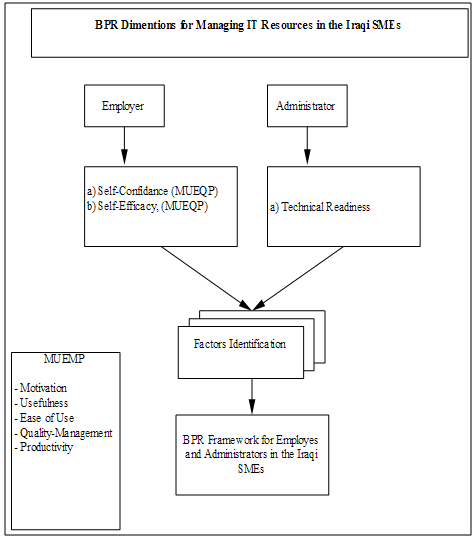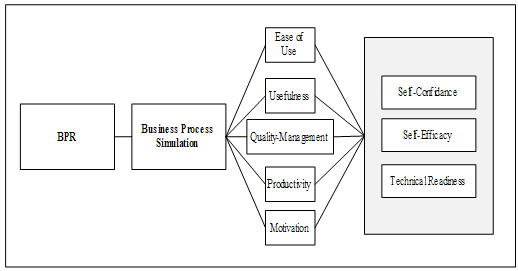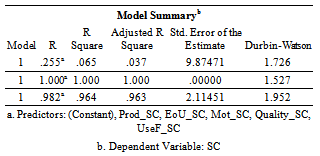-
Paper Information
- Next Paper
- Previous Paper
- Paper Submission
-
Journal Information
- About This Journal
- Editorial Board
- Current Issue
- Archive
- Author Guidelines
- Contact Us
Management
p-ISSN: 2162-9374 e-ISSN: 2162-8416
2013; 3(1): 45-49
doi:10.5923/j.mm.20130301.09
Building Self-confidence and Self-efficacy among Employees in the Iraqis Small and Medium Enterprises (SMES) Based on Business Process Reengineering (BPR) Tools: A Proposal New BPR Model
Muatamed Abed Hajer , Zawiyah Mohammad Yusof
Universiti Kebangsaan Malaysia, Malaysia
Correspondence to: Muatamed Abed Hajer , Universiti Kebangsaan Malaysia, Malaysia.
| Email: |  |
Copyright © 2012 Scientific & Academic Publishing. All Rights Reserved.
Iraq is now building its economy and infrastructure and has the potential to build a robust infrastructure based on a solid foundation. BPR could be applied to all business sectors. Iraqi government and businesses could achieve tremendous advantages by adopting BPR. Nowadays, Iraqi’s Small and Medium Enterprises (SMEs) faces difficulties in managing and improving the business structure. Many small companies conjectures that the importance of integrate new facilities to achieve the required improvements in their business needs. BPR tools and simulations are used in huge company; however, it is also needed by small and medium-size enterprises in human resource management in order to strengthen their business operation and management. This study involved the degree of readiness of the Iraqi SMEs for applying BPR tools in managing the business resources, ease of use, usefulness, quality management, employee’s self efficacy, self-confidence, and motivation. A quantitative research method was used using a questionnaire survey in order to verify these factors contribute to the use of BPR in the Iraqi SMEs. A total of 170 responses were collected from three enterprise companies in Baghdad. A framework of BPR tools in the Iraqi SMEs was produced to help these companies implementing BPR in order to develop employee’s motivation, self-efficacy, self-confidence, and quality.
Keywords: BPR, TQM, Business Management, SMEs
Cite this paper: Muatamed Abed Hajer , Zawiyah Mohammad Yusof , Building Self-confidence and Self-efficacy among Employees in the Iraqis Small and Medium Enterprises (SMES) Based on Business Process Reengineering (BPR) Tools: A Proposal New BPR Model, Management, Vol. 3 No. 1, 2013, pp. 45-49. doi: 10.5923/j.mm.20130301.09.
Article Outline
1. Introduction
- Business Process Reengineering is the analysis and redesign of workflow within enterprises. What constitutes dramatic change is the overhaul of organizational structures, management systems, employee responsibilities and performance measurements, incentive systems, skills development, and the use of information technology[1]. Successful BPR Model could result in enormous reductions in cost or cycle time[2]. It could also potentially create substantial improvements in quality, customer service, or other business objectives[3]. The utilization of BPR is not just considering the management process, but it also could produce revolutionary improvements for business operations. On the other hand, BPR projects may fail to meet the inherently high expectations of reengineering. Huq and Martin (2006) survey estimate the percentage of BPR failures is as high as 70%[4]. BPR is a method that promotes change and introduces new processes and new styles of working. BPR helps to carry different elements to make change possible. These elements are known as enablers and may be defined as elements that act as vehicles for processes to change[5].Some organizations have put forth extensive BPR efforts only to achieve marginal, or even negligible, benefits. Others have succeeded only in destroying the morale and momentum built up over the lifetime of the organization[6]. Many unsuccessful BPR attempts may have been due to the confusion surrounding BPR, and how it should be performed. Organizations are well aware that changes needed to be made, but did not know which areas to change or how to change[1].Iraqi SMEs deals with the business management from different directions. In general, there have limited use of BPR technology for managing the business recourses, which make bottleneck for both the input and output of information. Moreover, Iraqi SMEs faces difficulties in managing and improving the business structure. Many small companies conjectures that the importance of integrate new facilities to achieve the required improvements in their business needs. BPR tools and simulations are used in huge company; however, it is also needed by small and medium-size enterprises in human resource management in order to strengthen their business operation and management. Hence, the work in human resources could be done easily and faster by company especially in analyzing problems and helping to improve the employee’s confidence and efficacy while engaging with the business activities. Implementing a new business and finance strategies is new to the Iraqi SMEs, and the current Iraqi environment presents unique challenges for effective provision of financial and business services to the current business and their enterprises, as well as to small businesses in general. Therefore, examining the success factors for managing the business resources in Iraqi SMEs based on BPR tools or simulations is require, which may leads to strengthen the business operation, and challenge management to become more efficient and competitive. It provides the opportunity to reengineer the process or to reduce radically the number of activities it takes to carry out a process with the help of advanced IT and ICT strategies or mechanisms[7-10].
2. Framework
- Self-confidence for learning and development continues to receive increasing research interest, possibly due to its importance for employees’ work performance. It is however an under researched topic, particularly when it comes to the role that self-confidence for learning and development plays in employees’ reaction to organizational change. In the literature, self-confidence is also known as self-efficacy[11]. There has been a growing awareness in the organizational psychology literature that self-efficacy is a key determinant of individuals’ intention and choice to pursue an activity, which also relate to the self-efficacy in definite degree.As show in Figure 1 the proposed framework of BPR in the SMEs Iraqi companies. The proposed framework was developed to conclude the employee self-confidence and self-efficacy on the job motivation, ease of use, usefulness, productivity, and quality management based BPR tools, along with the technical readiness of BPR tools in the Iraqi SMEs. Each component contains a certain elements which adopted from the previous researches.
 | Figure 1. Conceptual Framework for Iraqi SMEs |
3. Method
3.1. Research Hypothesis
- Research hypotheses are the specific testable predictions made about the independent and dependent variables in the study[19]. The research hypothesis constructed in this study based on the conceptual framework such as the following:I. Hypothesis 1: The quality management of Iraqi SMEs employee is positively associated with the technical readiness, self-confidence, and self-efficacy.II. Hypothesis 2: The motivation is positively associated with the technical readiness, self-confidence, and self-efficacy.III. Hypothesis 3: The productivity is positively associated with the technical readiness, self-confidence, and self-efficacy.The proposed framework in Figure 1 above is based on the findings presented in the literature reviewed. Figure 2 shows the integration of the conceptual framework along with the research hypothesis.
 | Figure 2. Theoretical Framework |
3.2. Participants Selection
- In this study, the population refers to the entire group of business managers and employees in the Iraqis SMEs companies, which consist of 260 employees, a total of 230 employees were involved for data collection through questionnaire items. Employees were asked to navigate and use the BPR simulation (SFM) for three weeks, after that questionnaire was administrated among them to indicate their technical readiness, self-efficacy, and confidence to use SFM as a BPR tool in terms of quality, motivation, ease of use, usefulness, and productivity. A total of 170 responses were received from the total of 230 employees.
3.3. Research Instrument
- Questionnaire is the research instrument in this study. The advantage of the questionnaire is that the researcher could obtain quantitative data for analysis[20].[21] defines questionnaire as a pre-formulated written set of questions to which respondents record their answers, usually within rather closely defined alternatives. For the purposes of the study, the data will be gathered by means of a questionnaire.Using questionnaire for collecting research data means construct a self report data collection instrument that is filled by the research participants. Thus, the study distributed the questionnaire into certain number of business managers and employees in Iraq.
4. Result
- Hypotheses of this survey were tested using descriptive statistic, correlation, regression analysis, and factor analysis. With the values showed in Table 1, we can analyze and know whether the hypotheses made earlier are being supported or not. From Table 1, there is a row showing R-Square values which indicate the direction of relationship (positive or negative) between dependent variable and independent variable. The value of R range is from 1 to -1. The absolute value of R indicates the strength with larger absolute values indicating stronger relationships. Beside R-Square, we are also interested in Adjusted R-Square. Adjusted R-Square is generally considered to be a more accurate goodness-of-fit measure than R-Square. Adjusted R-Square measures the proportion of the variation in the dependent variable accounted for by the explanatory variables.
|
5. Conclusions
- A quantitative research method was used using a questionnaire survey in order to verify these factors contribute to the use of BPR in the Iraqi SMEs. A total of 170 responses were collected from three enterprise companies in Baghdad. A framework of BPR tools in the Iraqi SMEs was produced to help these companies implementing BPR in order to develop employee’s motivation, self-efficacy, self-confidence, and quality. The result showed that all the variables are positively correlated with each other.
 Abstract
Abstract Reference
Reference Full-Text PDF
Full-Text PDF Full-text HTML
Full-text HTML